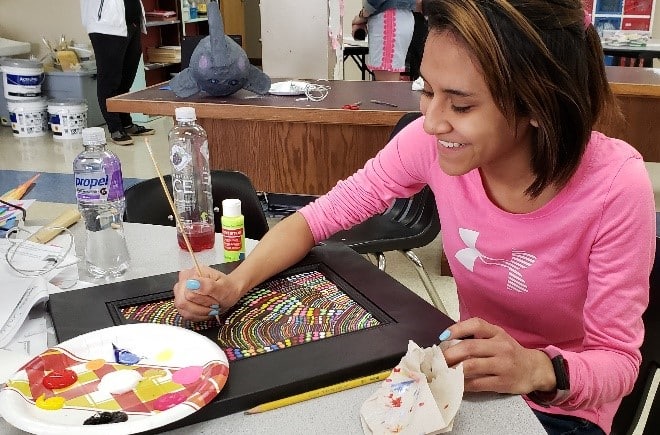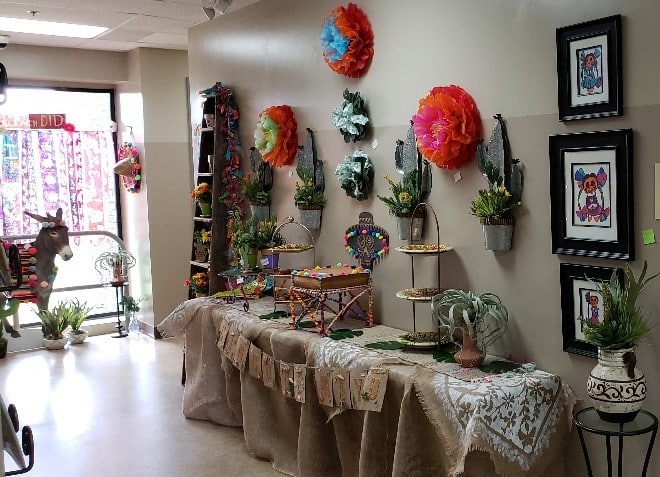Personalizing Learning in an Alternative Arts High School
CompetencyWorks Blog
This is the second post in a series about the Eastern Carver County Public Schools in Minnesota. Links to the other posts are provided at the end of this article.
 The Integrated Arts Academy (IAA) in Chaska, Minnesota brings a deeply personalized approach to embedding visual arts, culinary arts, horticulture, and floral and textile design into core academic subjects. Most of the high school’s 125 students arrive as juniors and seniors who struggled with academic engagement at their previous high school. The school used to be a program for these students in one of the district’s two large, comprehensive high schools.
The Integrated Arts Academy (IAA) in Chaska, Minnesota brings a deeply personalized approach to embedding visual arts, culinary arts, horticulture, and floral and textile design into core academic subjects. Most of the high school’s 125 students arrive as juniors and seniors who struggled with academic engagement at their previous high school. The school used to be a program for these students in one of the district’s two large, comprehensive high schools.
The leaders wanted to do something different, because the program’s graduation rate was too low. They decided to create a program where arts drove the learning. In 2012 they moved to a different building and began developing studios—one or more classrooms—related to several career paths. Some students come with a specific career in mind and spend much of their time in a single studio. Others want to be in an arts setting but don’t have a particular career in mind, and they divide their time across multiple studios.
 My visit was the day before the school’s Annual Gala, where students display and sell products from their projects. The halls were covered with displays of visual arts and flowers, the hydroponic gardens were in full bloom, and culinary students were preparing food for the event.
My visit was the day before the school’s Annual Gala, where students display and sell products from their projects. The halls were covered with displays of visual arts and flowers, the hydroponic gardens were in full bloom, and culinary students were preparing food for the event.
Principal Tera Kaltsas and a senior who had focused on culinary arts spoke with me and led my tour of the school. The student had earned a 3.7 GPA at their previous high school but seldom went to class. “I would do my work and then go take a nap. I literally napped in school daily. I was just there to get the grades, and that’s it. Then I went to the IAA gala at a friend’s invitation and was like ‘Oh my gosh, you like going to school and get to learn about things you want to learn about?’ I was a good student, but I wasn’t learning anything important. I was just doing worksheets and turning them in and then doing nothing. Then I came here and ran a coffee shop and became part of a great community. At my old school there were 3,000 kids. That’s too big for a school, and I didn’t know anyone. I wasn’t part of it. Here I know everyone and they all talk to me. It’s a community.”
The student described the coffee shop as a deeply engaging, motivating, and memorable learning experience. It involved planning logistics, budgeting for supplies, working with the health department to get a certification, opening the shop (inside the school), and managing student workers. In addition to culinary standards, the project met standards in math, English, and economics.
Many IAA students spend Wednesday afternoons outside of school doing authentic learning related to their interests in theaters, restaurants, farms, and a variety of other settings. When they’re working off campus, they enroll in a “work experiences” class that incorporates employment-related standards in addition to English, chemistry, and other academic disciplines.
IAA uses the district’s “power standards” in each academic area and often modifies the learning targets within those standards to reflect the activities in students’ individual projects. Students develop the projects and integrate the standards and learning targets in collaboration with their teachers. The school has invested years of effort in tailoring the district’s standards to be more applied and relevant to students’ interests.
(Eastern Carver explains their power standards as follows: “Our state standards are comprehensive and detailed and are recognized as some of the best in the nation. However, it is estimated that teaching all of them in-depth would take 20-plus years, whereas we have 13 years with students. Therefore, we have an on-going process to focus on the most important concepts and skills that students must learn. Eastern Carver County Schools calls these ‘Power Standards.’”)
Technology plays a major role in facilitating the development of IAA students’ projects. Currently the school is using Project Foundry as a learning management system, but they are transitioning to HeadRush. Project Foundry enables students to collaborate with teachers in entering project proposals, connecting the projects with required standards, and posting evidence of meeting the standards. The proposals include the main questions that the project will answer, intended products, tasks, and timelines. Head Rush and Project Foundry have many features in common, but IAA staff and students selected Head Rush for its ease of use, features for facilitating group projects, integration with Google products, and accessible tech support.
Over time the school has developed a “project bank” that provides ideas for how students can meet standards that may not fit well into particular arts areas. Students look through the project bank and select activities that are most interesting to them for standards they need to meet. They also consult teachers who can share ways that other students have met standards in the past.
Kaltsas noted that “Our focus isn’t English or math or any specific academic discipline. It’s application of that discipline in an art sense,” but also, “We’re always focused on ‘How do we meet the Minnesota criteria?’ and ‘How do we meet the students’ needs?’” The next post gets deeper into the discussion of how the Integrated Arts Academy integrates its arts-based, personalized approach into district and state expectations for student learning.
Other Posts in This Series
- District-wide Transformation to Personalized Learning in Eastern Carver County, Minnesota
- It Takes a Village to Personalize Learning to Every Student
- Flexible Scheduling, Supports, and Monitoring at Pioneer Ridge Middle School
- Strategies for Building Student Ownership of Their Learning
- Eastern Carver’s Framework for Lifelong Learning Skills
Learn More
- Is it a Project or an Activity? Project-Based Learning and its Cousins
- Project Example: Mobile App Design at Urban Assembly Maker Academy
- Active Learning through Expeditions and Internships at Four Rivers
Eliot Levine is the Aurora Institute’s Research Director and leads CompetencyWorks.